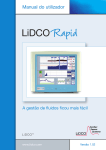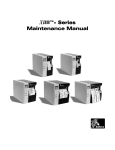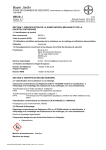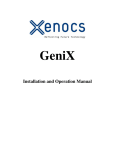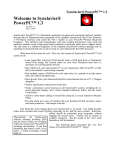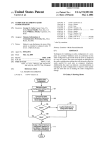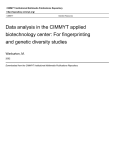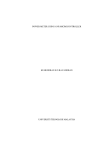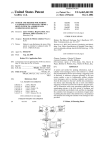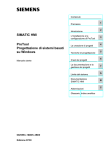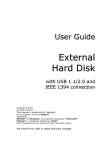Download Software image transition aid comprising building a disk image
Transcript
US006804774B1 (12) United States Patent (10) Patent N0.: (45) Date of Patent: Larvoire et al. (54) SOFTWARE IMAGE TRANSITION AID US 6,804,774 B1 Oct. 12, 2004 OTHER PUBLICATIONS COMPRISING BUILDING A DISK IMAGE BASED ON IDENTIFIED HARDWARE (75) Inventors: Jean-Francois Larvoire, Meylan (FR); RaZa et al., “Networking con?guration with plug—and—play components”, Dept. of Syst. & Comput. Eng., Carleton Univ., Ottawa, Ont.; Intergrated Network Management, Francois-Xavier Lecarpentier, 1999. Distributed Management for the Networked Millen Sassenage (FR) nium. On pp.: 937—938. 01999.* “AlohaBob’s PC—Relocator” User Manual v1.2, Eisen (73) Assignee: Hewlett-Packard Development Company, LP, Houston, TX (US) world, Copyright 1999, pp. 1—28. “Disk Cloning Technology for the Overburdened IT Profes sional”, Symantec Paper Series, vol. XIIII, Symantec Corp., (*) Notice: Subject to any disclaimer, the term of this patent is extended or adjusted under 35 Copyright 1998, pp. 1—14. U.S.C. 154(b) by 521 days. * cited by examiner Primary Examiner—Thomas Lee Assistant Examiner—Eric Chang (21) Appl. No.: 09/630,754 (22) Filed: Aug. 2, 2000 (30) Foreign Application Priority Data May 12, 2000 (51) (52) (58) (57) (EP) .......................................... .. 00410050 Int. Cl.7 .............................................. .. G06F 9/445 US. Cl. .......................... .. 713/2; 717/174; 717/175 Field of Search .............................. .. 713/1, 2, 100; 703/23 (56) ABSTRACT A software image transition aid is described for acting on a software image that is transferred from a source computer to a target computer, the aid comprising: a bootable storage media with stored thereon one or more operating systems arranged to load when the target computer is booted from the storage media and program code elements arranged to modify the cloned disk image under the control of the operating system or systems, so that when the target com References Cited puter is rebooted from the transferred image the target U.S. PATENT DOCUMENTS computer will reach an operational state. The tool can be used in the following way. First the user transfers the 5,555,416 A * 9/1996 Owens et al. ............. .. 717/178 complete operational software image from the target PC 5,604,906 * 2/1997 Murphy et al. onto a source PC. Then, before being booted from the cloned A ..... . . . .. 717/162 5,835,777 A * 11/1998 Staelin .............. .. 717/175 image, the target computer is booted from the image tran 5,870,610 * Beyda sition aid. The image transition aid acts on the software image stored on the hard disk in the target computer. Once A 2/1999 .. ... ... . 5,978,590 A * 11/1999 Imai et al. 6,304,965 B1 * 10/2001 6,449,682 B1 * 9/2002 Rickey . ... ... . Toorians ...... . . . .. 717/173 717/177 . . . . . . .. . . . .. 713/2 711/100 6,466,972 B1 * 10/2002 Paul et al. ................ .. 709/222 the process in completed the target computer is rebooted to load the operating system that was transferred with the software image. FOREIGN PATENT DOCUMENTS EP 0965915 A2 * 12/1999 22 Claims, 4 Drawing Sheets U.S. Patent 0a. 12, 2004 Sheet 1 0f 4 US 6,804,774 B1 Boot under Dos Initiaiisation '’ Create Ramdn've 100 /120 Copy ?ies to Ramdrive “130 V 140 Detect PC type Jr Detect Hardware " 150 l Analysis Q Check presence of OS , 160 + / 170 Export Registry Keys J, Check availability 0f ._ 180 Drivers L 190 No OK \0 Adapt? /200 Copy Drivers Adaptation i l , 210 Save Lan con?guration Elgl __1____ - 220 Update Registry I End U.S. Patent 0a. 12, 2004 Sheet 2 0f 4 US 6,804,774 B1 ‘ 230 Boot under Windows 95 Restore Network \ 240 configuration Restart / 270 U.S. Patent Oct. 12, 2004 US 6,804,774 B1 Sheet 3 0f 4 / 300 Boot under Dos initialisation % Store system snapshot /32O ‘L Create Ramdrive #330 y. /_ N/ 340 Detect Hardware t Analysis 4 / 350 Copy files to Ramdrive l Restore system state / 360 U.S. Patent 0a. 12, 2004 Sheet 4 0f 4 US 6,804,774 B1 f A 370 Reboot in Ramd rive V 380 Read HNV information / i 390 Remove unnecessary Adaptation < Drivers 7 400 Add necessary drivers , Restore Lan and Vld€0 con?guration ._ 410 US 6,804,774 B1 1 2 SOFTWARE IMAGE TRANSITION AID COMPRISING BUILDING A DISK IMAGE BASED ON IDENTIFIED HARDWARE The present invention is directed to speeding up and easing generally the migration of a softWare environment from a source computer to a target computer. SUMMARY OF THE INVENTION In brief, this is achieved by a softWare image transition aid FIELD OF THE INVENTION for acting on a softWare image that is transferred from a source computer to a target computer, the aid comprising: a The present invention relates to computers and, more particularly, to a software tool for assisting a computer user in converting a softWare image operational on a source personal computer for use on a target personal computer. bootable storage media With stored thereon one or more operating systems arranged to load When the target computer is booted from the storage media and program code elements arranged to modify the cloned disk image under the control BACKGROUND OF THE INVENTION of the operating system or systems, so that When the target computer is rebooted from the transferred image the target Usually personal computers are supplied by their manu facturer With an operating system and certain application programs already installed on the hard disk. HoWever, many computer Will reach an operational state. In preferred embodiments, the program code elements can be arranged to: identify the hardWare of the target computer; analyse the softWare image on the hard disk; identify ?les to computer users Wish to install their oWn custom image, or retain the Working environment from their old PC, but face the problem that building a softWare image like this for use The same issue is faced by potential purchasers of comput be added to the transferred image; and copy the identi?ed ?les from a repository to the transferred image, Whereby When the target computer is rebooted from the transferred ers Who ?rst Wish to test a neW model With the production image, an operating system therein ?nds the required ?les. With a neW personal computer can be very time consuming. environment or applications used for instance throughout a This kind of tool can be used in the folloWing Way. First large company. the user transfers the complete operational softWare image The task of recreating the computing environment Will generally involve a user installing the operating system, then all their desired applications. Finally the user must copy all their data ?les from Wherever they are stored. At best, this process Will take several hours. HoWever, if it is unsuccessful, the problems can be difficult to diagnose and resolve. Specialised transfer applications, such as the “Alohabob’s PC Relocator” product available from EisenWorld Corp, do eXist for copying applications and data from an old PC to the neW one. HoWever, these applications are generally not 25 from the target PC onto a source PC either by using a suitable cloning tool of Which there are several commer cially available, or by physically removing the disk drive containing the softWare image from the source computer and ?tting it into the target computer. Then, before being booted from the cloned image, the target computer is booted from the image transition aid. The image transition aid acts on the softWare image stored on the hard disk in the target computer to at least add any necessary 35 ?les, for instance missing drivers. In preferred embodiments, other operations are performed at this stage ideal, primarily because of the dif?culty of distinguishing also, for instance drivers that are already present in the user applications from operating system accessories. Since image may be removed in order to ensure a clean installation of the neW drivers. the old and neW PC often do not have the same operating system version, the resulting con?guration can be unstable, With old operating system ?les overWriting neWer ones 40 Once the process in completed the target computer is rebooted to load the operating system that Was transferred already present on the neW PC. With the softWare image. The operating system ?nds all the Disk cloning applications, such as the Norton Ghost Application available from Symantec Corporation, are also Widely used, but these face the problem that the neW PC Will usually be made up of different hardWare components and ?les necessary for it to be operational on the target computer, and is able to boot. The invention is based, at least in part, on consideration of the problems encountered using the knoWn methods of disk image migration. It has been found that adding support for the target hardWare is an important issue and that by therefore the correct drivers for the neW hardWare compo nents Will need to be installed from someWhere. Since the hardWare components of the neW PC may not have eXisted When the old PC Was bought, the correct drivers may not be present on either the hard disk of the old PC or Whatever adding this support before the operating system image is booted on the target machine for the ?rst time, it is possible to prevent numerous error messages, and avoid the user accompanying support media Were supplied With it. The having to manually respond to lots of questions that Would be generated by the operating system When discovering neW drivers for the neW hardWare Will therefore have to be obtained from elseWhere. Using this disk cloning approach, it has been found hardWare or installing neW drivers. that 55 con?icts can occur When a neW version of a driver is BRIEF DESCRIPTION OF THE DRAWINGS installed When in fact an older driver is already present on SoftWare tools embodying the invention Will noW be the disk and (ii) that con?guration settings, such as the described, by Way of non-limiting example, With reference to the accompanying diagrammatic draWings, in Which: computer name, TCP/IP settings and the like are lost so that the drivers need to be recon?gured, Which takes time and FIG. 1 is a How diagram shoWing the main steps of operation of a softWare tool for use With WindoWs 95 requires the necessary settings to be knoWn by the person carrying out the operation. The complexity of modern PC systems means that these kind of versioning and hardWare con?icts are hard to avoid, particularly given the likelihood that some or all of the softWare components Will, to a greater or lesser eXtent, contain bugs. softWare images; 65 FIG. 2 is a How diagram shoWing the second part of the transition process for the tool; FIG. 3 is a How diagram shoWing the main steps of operation of a softWare tool for use With WindoWs NT softWare images; US 6,804,774 B1 3 4 FIG. 4 is a How diagram showing the second part of the transition process carried out by the tool of FIG. 3. version on HP Vectra, Kayak or Brio platforms. Such facilities are often provided in modern personal computers to alloW softWare packages to use this information to install BEST MODE OF CARRYING OUT THE INVENTION the appropriate versions of drivers or hardWare-dependent In the following, tWo embodiments Will be described for use With the Microsoft WindoW 95 and NT4 operating systems respectively. It Will be understood that the same DOS-based program that employs standard plug and play application programs. In step 150, the hardWare of the PC is discovered using a enumeration techniques like those used in the WindoWs Con?guration Manager. As is Well knoWn, the term Plug and Play refers to a technology, including associated technical standards, that supports automatic con?guration of PC hard approach may also be used With other operating systems, such as Linux, the problems described being generally associated With the need to quickly and conveniently convert Ware and attached devices. The technology alloWs a user to attach a neW device such as sound or fax card and start a softWare disk image that is operational in a source com puter for use in a target computer in circumstances Where the source and target computers have different hardWare con ?gurations and Where the necessary drivers for the target 15 hardWare may not have been available When the source PC Was manufactured or con?gured so that it Would have been Working Without having to con?gure the device manually. The technology is implemented by suitable features in hardWare in the form of devices that can identify themselves and can be con?gured via standard softWare interfaces instead of jumpers or proprietary interfaces, and by suitable impossible to supply them With the softWare delivered With features in operating systems such as Microsoft WindoWs 95, and in supporting softWare such as drivers and BIOS. An the source computer. These kinds of tools are used in the folloWing Way. First operating system assigns system resources like I/O the user transfers the complete operational system image addresses and IRQs and drivers obtain these resource set from the target PC onto a source PC either by using a tings from the operating system. In personal computer systems designed to operate With suitable cloning tool or by physically removing the disk drive containing the softWare image from the source com puter and ?tting it into the target computer. Then, before booting the target computer from the cloned disk, the system 25 EISA, PCMCIA, etc.—is a Plug and Play device. is booted from a separate bootable media to load an oper A key component of WindoWs 95 is a program called the Con?guration Manager that makes use of other programs such as enumerators, arbitrators, device loaders, and device drivers to discover the hardWare con?guration. Both the Con?guration Manager and the enumerators make use of a system-Wide binary database knoWn as the registry, that is accessible to the WindoWs 95 components and applications ating system contained on the bootable media. Suitable programs also contained on the bootable media are then executed and serve to modify the cloned image so that it Will boot successfully and result in an operational system In these embodiments, the softWare described is all con tained in a single bootable CD-ROM, although it Will be understood that any form of bootable storage media may equally be used. When the CD-ROM is inserted in the CD the WindoWs operating systems, any device for one of the more recently standardised expansion buses—such as PCI, 35 to store and retrieve information about devices and their drivers, such as possible device con?gurations, device manufacturer, and the driver revision number. The registry is hierarchically structured, like a tree, With each node being drive of the target PC, an OS contained on the disk is launched. Once the OS is launched, softWare also contained on the CD is run under that operating system to analyse and referred to as a key. One or more pieces of data, called make changes to the softWare image. FIG. 1 is a How diagram shoWing the main steps of values, can be associated With each key. A key can have subkeys, Where each subkey is itself a tree With its oWn 40 values and subkeys. operation of the softWare tool in an embodiment of the invention for use With WindoWs 95. In this embodiment, the OS ?rst launched from the CD is a version of the Well knoWn DOS operating system. The ?rst step of the process is therefore the booting of the DOS operating system, shoWn After checking the hardWare, a program checks the pres 45 this boot disk for the WindoWs directory variable. If the result is correct, it sets the environment variables, “Winboot dir” and “PATH”, With the right value. It also sets the Registry key to read in the “REGKEY” variable. The as step 100. At the launch, various options and parameters such as directory paths, the environment siZe and like parameters, CurrentVersion Key of the registry is exported in step 170. The availability of the drivers corresponding to the Hard are initialised and a progress bar is displayed on the screen. In addition, a RAM drive is created—step 120—that Will be used to store various temporary ?les that are generated during the transition process. As is Well-knoWn, a Ramdrive is a portion of RAM that has been con?gured to simulate a disk drive. Files on a RAM disk can be accessed in the same 55 Way as ?les on a real disk drive. Certain ?les, such as the xcopy program and font ?les, are copied from the CD to the RAM drive for more ef?cient operation—step 130. When the initialisation is ?nished, a Welcome screen is displayed to the user (step not shoWn in FIG. 1) to inform them of the function of the softWare and Warn them of the possible risks of its use, since the changes made to the softWare image by the tool Will be irreversible. FolloWing the initialisation, an analysis is carried out of the target PC. The PC identi?er is determined—step 140. On HP computers this is achieved by using a simple DOS utility that is able to return the PC model, serial number, or BIOS ence of the WindoWs operating system itself—step 160—by searching the boot disk, then scanning the msdos.sys ?le in Ware detected by the PnP softWare is checked in step 180. This is done by scanning the database of drivers available on the CD. Once the hardWare has been analysed the user is prompted to indicate Whether they Want to continue and actually make changes to the softWare image. If the decision is yes, the drivers and OS kernel ?les corresponding to the hardWare components of the target PC are copied to the correct place, ie the Inf and Cabs directories. The Registry is updated to keep the NetWork con?guration and set the key to the install of the driver. A registry ?le is created in the Cabs directory containing some keys that Will need to be added after the HardWare is con?gured. 65 Finally, a executable program—viZir2.exe—that Will con trol the second part of the transition process is copied to the RAM drive. US 6,804,774 B1 5 6 In step 210, the network parameters—IP Address, IP Mask, IP Gateway, IP Device, WNS Name Server Device, Logon NT Domain, DNS Information, if they exist—are saved to a special key in the registry. The autologon key is memory. This is shown as step 320. This stored snapshot includes all interrupt vectors, the BIOS data areas (BDA and XBDA), and the states of some critical hardware devices. This information is used later in the process to put the system in a valid state before rebooting. The next DOS driver loaded is the DOS memory manager set so that hardware installation is automatic. Various other keys are set in the Registry—in step 220—to allow the newly copied drivers to be installed smoothly and for the ?le viZir2.exe to be automatically executed once the PC is rebooted. The boot on CD facility is disabled to allow the PC to be rebooted from its hard disk. Finally, the PC is rebooted. FIG. 2 shows the main steps of the second part of the (HIMEM.SYS). An option is used to put aside the ?rst half of extended memory. This memory is used later in the 10 The next DOS driver to be loaded is the PAM-Drive driver. As is well-known, a PAM-Drive is a portion of RAM Windows 95 OS present on its hard disk and that was cloned from the source machine. As part of this process, the new 15 HIMEM.SYS. This is shown as step 330. Then SCSI and CD-ROM drivers are then loaded. These allow the boot device to be accessed. In other embodiments, suitable network drivers or the like might be loaded to allow An equivalent software tool will be described for use with access to resources via a network, for instance. When the DOS initialiZation is ?nished, the ?rst stage of the Image Transition itself begins. This ?rst stage is run menting this kind of tool under Windows NT is that some 25 is done using standard plug and play enumeration techniques, recursively scanning all buses starting from the boot at all on a new hardware con?guration. Furthermore, processor. Additional information is returned by calls to the the ?le system used by Windows NT cannot be used by DMI BIOS. At this stage, it is not possible to write results to the hard DOS. It is therefore necessary to ?nd a way of both detecting the hardware present on the machine and processing the disk 35 40 single ?oppy disk image is the NT bootstrap loader, called the “NT loader”. Unfortunately, the NT loader does not have support for the CD ?le system. Furthermore, NT does not which is con?gured so that it will boot on the new hardware and permit access to the Windows NT ?le system in order to 45 including the Transition Tool applications and the unat tended packages (drivers and utilities) and a directory including Windows ?les needed during Phase 2 and Phase 3. As will be described below, a custom DOS driver is provided that serves to restart the machine and to boot Windows NT from the ram-drive. This program serves to 55 capture required interrupt addresses and to actually restart the machine and to boot Windows NT from the Ram-drive disk. FIG. 3 is a How diagram showing the main steps of operation of the software tool. The OS ?rst launched from the CD is a version of the well known DOS operating system. The ?rst step of the process is therefore the booting of the DOS operating system, shown next operating system—Windows NT in this embodiment. Windows NT is a large operating system—too large to boot from a single ?oppy disk image. What will ?t on a certain Windows NT program ?les, to the RAM-Drive. The second is a suitably con?gured copy of Windows NT itself make the modi?cations necessary for the cloned copy of Windows NT to be booted successfully. The bootable CD includes a bootable partition with MS-DOS; a bootable partition with needed ?les to boot Windows NT in Phase 2 and a data partition with a directory disk, which may not be accessible, if formatted with the NT ?le system. In consequence, the results of the plug and play analysis are stored in ?les in the RAM drive. The next stage consists in preparing the reboot under the provided on the bootable CD-ROM. As will be described in more detail below, the ?rst operating system serves to provide an environment for creating a RAM-Drive, detect ing the hardware and copying necessary ?les, including under DOS. Awelcome screen is displayed to warn the user about possible consequences, and get their agreement to continue. Then a full plug and play enumeration of all hardware devices present in the PC is done—step 340. This and Play” technology supported by the Windows 95 and DOS operating systems can be used for this. However, Windows NT does not itself support plug and play func tionality and usually a cloned copy of Windows NT will not image without booting Windows NT from the cloned disk. To achieve this, two bootable operating systems are that has been con?gured to simulate a disk drive. Files on a RAM disk can be accessed in the same way as ?les on a real disk drive. The RAM-Drive is physically allocated in second half of extended memory, after the block put aside by the Microsoft NT4 operating system. A dif?culty of imple kind of capability is required that supports automatic con ?guration of PC hardware and attached devices. The “Plug of contiguous memory will be available for the next oper ating system. transition process. In step 230 the computer boots from the drivers are automatically installed by the install functionality present in the operating system. In step 240 the network con?guration is restored and the protocols rebound to the NIC present in the target PC. Finally, the PC is restarted in step 270 and the transition process is complete. process by the next operating system after the reboot. Putting it aside at this stage ensures that a big enough block support booting from read-only media. So the approach adopted in this embodiment consists in copying an NT kernel from the CD to the RAM Drive—step 150. The RAM Drive is formatted as a DOS FAT drive. And it is writable. The NT kernel includes drivers for all known ?le systems. An NT boot ?oppy, containing the NT Loader, and a customiZed RAM-Drive driver instead of the normal IDE hard disk driver is contained as the second boot image on the CD. After all the above steps, a second instance of the custom DOS driver is loaded, which works in cooperation with the ?rst instance loaded earlier in the process. The second instance of the custom DOS driver issues a software inter rupt 19h. This interrupt is the standard BIOS call for rebooting without running POST. The last driver to receive the interrupt 19H is the one that was loaded ?rst, that is the ?rst instance of the custom DOS driver. In order to ensure the system is a state from which it can be rebooted, the custom DOS driver uses the stored snapshot of the initial system state, and restores everything as step 300. 65 to the actual state it was in after POST. This way, it’s safe The very ?rst DOS driver loaded is a custom DOS driver to reboot without running POST again. This is shown as step 360. which stores a snapshot of the system at the end of POST in US 6,804,774 B1 8 7 In principle, device drivers should respond to interrupt 19h by releasing allocated resources, and returning the copy the identi?ed ?les from a repository to the disk system to its initial state. HoWever, in practice many device image, Whereby When the target computer is rebooted drivers do not do this. Most drivers have no provision from the disk image, an operating system therein ?nds identify ?les to be added to the disk image; and Whatsoever for releasing the resources they may have used, and restoring the system to its initial state. That is Why it is necessary to have custom DOS driver restore the system to its initial state. The ?rst instance of the custom DOS driver then transfers control to the second instance. This second instance uses the the required ?les. 2. A softWare image transition aid as claimed in claim 1 Wherein the bootable media includes a repository of ?les potentially required for the disk image to be operational in the target computer. 10 El Torito API to select the second boot image on the CD, and boot from it—step 370 shoWn in FIG. 4. The NT loader Plug and Play enumeration techniques. starts, and proceeds by loading the NT kernel from the RAM-Disk. Once the NT operating system is up and running, the second stage of the Image Transition process begins. The 3. A softWare image transition aid as claimed in claim 1 Wherein the code elements for identifying the hardWare use 15 4. A softWare image transition aid as claimed in claim 1 in the form of a single CD. 5. A softWare image transition aid as claimed in claim 1 Wherein the copied ?les comprise drivers. 6. A softWare image transition tool as claimed in claim 1 comprising program code elements for creating a ramdrive second stage is carried out by a Win32 program run from the CD. All the necessary hardWare information is read from the ?les left by stage 1 in the RAM drive—step 380. Then this for storing temporary data used during the transition pro information is compared to the database of device drivers on the CD, and the list of necessary drivers is built. These are cess. then installed in phases. First there’s a cleanup phase: The transition program comprising program code elements for identifying settable parameters in the disk image; saving the set values of said parameters in storage and restoring said parameters When the disk image has been adapted for use With the target 7. A softWare image transition tool as claimed in claim 1 accesses the hard disk, Which is noW feasible as this instance of NT has drivers for all supported ?le systems. On the hard 25 disk, it accesses the target operating system’s registry. All computer. user settings, such as LAN protocols, video con?guration, 8. A softWare image transition tool as claimed in claim 7 Wherein the settable parameters are netWork parameters. 9. A softWare image transition aid as claimed in claim 1 Wherein the bootable media is provided With ?rst and second etc, are saved and all drivers that are NOT necessary for the target PC—step 390 are removed. Then there’s a rebirth phase: It adds the minimal set of drivers necessary for reboot. This is done to limit risks taken by not running the normal driver setup programs. All other necessary drivers setup programs are then copied to the hard disk, and scheduled to run at the neXt boot—step 400. Finally, the machine is rebooted on its hard disk for the ?rst time. NT starts. The setup programs for the remaining operating systems and program elements arranged to: boot the ?rst operating system from the bootable media, reserve an area of memory and perform a ?rst task under 35 memory area; reboot the computer so as to load a second operating devices (non boot devices, such as audio, LAN, etc) run. The machine is rebooted a last time, and should then be fully functional. The last task of Image Transition is to restore all user settings, such as LAN protocols, video con?guration, etc, to their initial state. This is necessary since many devices setup programs reset the con?guration of above softWare layers to their default value. Although a speci?c embodiment of the invention has been described, the invention is not to be limited to the speci?c 40 system from the bootable media; and perform under the control of the second operating system a second task using the stored results. 10. A softWare image transition aid as claimed in claim 9 Wherein booting the ?rst operating system includes perform ing a poWer-on self test (POST), the arrangement compris ing program elements for saving an initial system state after the POST and, prior to the reboot, restoring the system state arrangement so described. The invention is limited only by as it Was saved folloWing the POST. the claims. The claims themselves are intended to indicate the periphery of the claimed invention and are intended to be 11. A softWare image transition aid for acting on a disk image that is cloned or stored on a storage media that is physically transferred from a source computer to a target interpreted as broadly as the language itself alloWs, rather than being interpreted as claiming only the exemplary embodiment disclosed by the speci?cation. What is claimed is: 1. A softWare image transition aid for acting on a disk image that is cloned or stored on a storage media that is the control of said ?rst operating system; store results generated by said ?rst task in the reserved computer, the aid comprising: a bootable storage media With stored thereon a ?rst operating system arranged to load When the target computer is booted from the storage media and program code elements arranged to: 55 physically transferred from a source computer to a target identify the hardWare of the target computer; computer, the aid comprising: a bootable storage media With stored thereon an operating system arranged to load When the target computer is booted from the storage media and the disk image on a hard disk; copy the identi?ed ?les from a repository to the disk program code elements arranged to modify a cloned or image, Whereby When the target computer is rebooted identify ?les to be added to the disk image; and physically transferred disk image under the control of the operating system, so that When the target computer is from the disk image, a second operating system therein ?nds the required ?les and is able to reach an opera rebooted from the cloned or physically transferred disk tional state. image the target computer Will reach an operational state, Wherein the program code elements are arranged to: identify the hardWare of the target computer; the disk image on a hard disk; 65 12. AsoftWare image transition aid as claimed in claim 11 Wherein the bootable media includes a repository of ?les potentially required for the disk image to be operational in the target computer. US 6,804,774 B1 10 from the disk image, an operating system therein ?nds 13. A software image transition aid as claimed in claim 11 wherein the code elements for identifying the hardWare use the required ?les. Plug and Play enumeration techniques. 19. A tool as claimed in claim 18 comprising program code elements for identifying settable parameters in the disk image; saving the set values of said parameters in storage and restoring said parameters When the disk image has been adapted for use With the target computer. 14. A softWare image transition aid for acting on a disk image that is cloned or stored on a storage media that is physically transferred from a source computer to a target computer, the aid comprising: a bootable storage media With stored thereon an operating system arranged to load When the target computer is booted from the storage media; a 20. A tool as claimed in claim 19 Wherein the settable parameters comprise netWork parameters. 21. A softWare image transition aid for acting on a ?rst storage media that is physically transferred from a source computer to a target computer, said ?rst storage media including a ?rst operating system that is bootable on said source computer, the aid comprising: a second bootable repository of ?les potentially required for the disk image to be operational in the target computer; and program code elements arranged to: identify the hardWare of the target computer using Plug and Play enumeration techniques; the disk image on a hard disk; 15 identify ?les to be added to the disk image; and copy the identi?ed ?les from a repository to the disk image, storage media With stored thereon a second operating system arranged to load When the target computer is booted from the second storage media and program code elements arranged to: Whereby When the target computer is rebooted from the disk image, an operating system therein ?nds the required ?les. identify the hardWare of the target computer; the ?rst storage media; 15. AsoftWare image transition aid as claimed in claim 14 in the form of a single CD. 16. A softWare image transition tool as claimed in claim identify required ?les to be added to a disk image; and copy the identi?ed required ?les from a repository to the 14 comprising program code elements for identifying set table parameters in the disk image; saving the set values of said parameters in storage and restoring said parameters When the disk image has been adapted for use With the target ?rst storage media, Whereby When the target computer 25 able to reach an operational state. 22. AsoftWare image transition aid for acting on a cloned data image that is copied from a source computer to a target computer. 17. A softWare image transition tool as claimed in claim 16 Wherein the settable parameters are netWork parameters. 18. A tool in the form of a single CD for acting on a disk image that is cloned or stored on a storage media that is computer, said cloned data image being bootable on said source computer and including a ?rst operating system, the aid comprising: a bootable storage media With stored thereon a second operating system arranged to load When the target computer is booted from the second storage media and program code elements arranged to: physically transferred from a source computer to a target computer, the aid comprising: a bootable storage media With stored thereon an operating system arranged to load When the target computer is booted from the storage media; a 35 repository of ?les potentially required for the disk image to be operational in the target computer; and program code elements arranged to: identify the hardWare of the target computer using Plug and Play enumeration techniques; is rebooted from the ?rst storage media, the ?rst operating system therein ?nds the required ?les and is identify the hardWare of the target computer; the cloned data image; identify required ?les to be added to the cloned data image; and copy the identi?ed required ?les from a repository to the 40 cloned data image, Whereby When the target computer the disk image on a hard disk; is rebooted from the cloned data image, the ?rst oper ating system therein ?nds the required ?les and is able identify ?les to be added to the disk image; and to reach an operational state. copy the identi?ed ?les from a repository to the disk image, Whereby When the target computer is rebooted * * * * * UNITED STATES PATENT AND TRADEMARK OFFICE CERTIFICATE OF CORRECTION Page 1 of 1 PATENT NO. : 6,804,774 B1 DATED : October 12, 2004 INVENTOR(S) : Jean-Francois Lavoire et al. It is certified that error appears in the above-identi?ed patent and that said Letters Patent is hereby corrected as shown below: Column 7 Line 67, change “the disk image on a hard disk” to -- analyse the disk image on a hard disk - Column 8 Line 57, change “the disk image on a hard disk” to -- analyse the disk image on a hard disk - Column 9 Lines 16 and 142, change “the disk image on a hard disk” to -- analyse the disk image on a hard disk - Column 10 Line 20, change “the first storage media” to -- analyse the first storage media Line 20, change “the cloned data image” to -- analyse the cloned data image - Signed and Sealed this Second Day of August, 2005 m Wguw JON W. DUDAS Director ofthe United States Patent and Trademark O?‘ice











